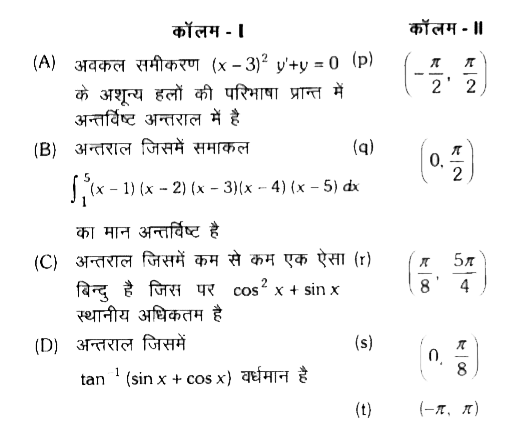यदि F(u)=f(x,y,z),x,y,z में n घाट का समघातीय फलन हो , तब xϑuϑx+yϑuϑy+zϑuϑz=
nu
nF(u)
nF(u)F'(u)
इनमे से कोई नहीं
The correct Answer is:C
Step by step video, text & image solution for यदि F(u)=f(x,y,z),x,y,z में n घाट का समघातीय फलन हो , तब x(varthetau)/(varthetax)+y(varthetau)/(varthetay)+z(varthetau)/(varthetaz)= by Maths experts to help you in doubts & scoring excellent marks in Class 12 exams.
Updated on:21/07/2023Topper's Solved these Questions
- अवकलन तथा अवकलज के अनुप्रयोगBook:ERRORLESS HINDIChapter:अवकलन तथा अवकलज के अनुप्रयोगExercise:MULTIPLE CHOICE QUESTIONS (एक बिन्दु पर अवकलज,मानक अवकलज)
Explore 186 Videos
- अवकलन तथा अवकलज के अनुप्रयोगBook:ERRORLESS HINDIChapter:अवकलन तथा अवकलज के अनुप्रयोगExercise:MULTIPLE CHOICE QUESTIONS (अस्पष्ट फलनों का अवकलन,प्रचलिक व संयुक्त फलनों का अवकलन,लघुगणकीय अवकलन, अनन्त श्रेणियों के अवकलन )
Explore 64 Videos
- अवकल समीकरण Book:ERRORLESS HINDIChapter:अवकल समीकरण Exercise:JEE Advanced ( Matrix Match type questions )
Explore 3 Videos
- केन्द्रीय प्रवृत्ति के मापBook:ERRORLESS HINDIChapter:केन्द्रीय प्रवृत्ति के मापExercise:Jee Advanced (Reasoning )
Explore 2 Videos
Similar Questions
2f(x)=f'(x) एवं f(0)=3, तब f(2)=
View Solutionमाना y,x2x−2xxcoty−1=0 से परिभाषित x का एक अस्पष्ट फलन है। तब y'(1) बराबर है
View Solution
View Solutionकथन - 1 : प्रथम n सम धन पूर्णांकों का प्रसरण n2−14 है।
कथन - 2 : प्रथम n धन पूर्णाको का योगफल n(n+1)2 और प्रथम n धन पूर्णांको के वर्गों का योगफल n(n+1)(2n+1)6 है।
View SolutionIf u=(x+y)/(x-y) , so (varthetau)/(varthetax)+(varthetau)/(varthetay) =
View SolutionIf u=sin^(-1)((y)/(x)) , so (varthetau)/(varthetax) =
View SolutionIf u="tan"^(-1)(y)/(x) , By oil love x(varthetau)/(varthetax)+y(varthetau)/(varthetay) =
View SolutionIf F(u)=f(x,y,z),x,y,z If n is the quadratic function of the ghat, then x(varthetau)/(varthetax)+y(varthetau)/(varthetay)+z(varthetau)/(varthetaz) =
View SolutionIf u=log(x^(3)+y^(3)+z^(3)-3xyz) so ((varthetau)/(varthetax)+(varthetau)/(varthetay)+(varthetau)/(varthetaz))(x+y+z)=
View SolutionIf x^(x)y^(y)z^(z)=c , so (varthetaz)/(varthetax)=
View Solutionu=tan^(-1)((x^(3)+y^(3))/(x-y)) , Then x(varthetau)/(varthetax)+y(varthetau)/(varthetay)=
View SolutionIf u=tan^(-1)(x+y) , so x(varthetau)/(varthetax)+y(varthetau)/(varthetay)=
View SolutionIf u=(x^(2)+y^(2)+z^(2))^(3//2) , so ((varthetau)/(varthetax)) +((varthetau)/(varthetay))^(2)+((varthetau)/(varthetaz))^(2) =
View SolutionIf (x+y)sinu=x^(2)y^(2) , Then x(varthetau)/(varthetax)+y(varthetau)/(varthetay) Is equal
View Solutionयदि u=x+yx−y, तो ϑuϑx+ϑuϑy=
View Solution

